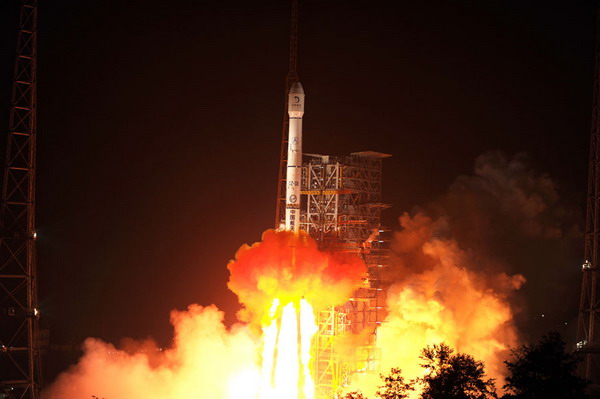BEIJING - China launched the country's first moon rover aboard its Chang'e-3 lunar probe on Monday, bringing Chinese dreams of reaching the moon tantalizingly close.
If Chang'e-3 successfully soft-lands on the moon in mid-December as scheduled, China will become the third country, after the United States and the former Soviet Union, to do so.
 |
|
The Long March-3B carrier rocket carrying China's Chang'e-3 lunar probe blasts off from the launch pad at Xichang Satellite Launch Center, Southwest China's Sichuan Province, Dec 2, 2013. [Photo by He Haiyang / Asianewsphoto] |
Space exploration has been a risky undertaking. Only 51 percent of mankind's 129 lunar probe attempts have been successful.
The successful launch is only the first step of the Chang'e-3 mission. Over the coming months. it will have to withstand multiple tests of soft landing, the separation of the rover from the lander, survival on the moon surface and remote control.
The moon rover is tasked with surveying the moon's geological structure, surface substances and looking for natural resources.
Chang'e-3 is part of the second phase of China's lunar program, which was initiated in 2004 and includes orbiting, landing and returning to Earth. It follows the success of the Chang'e-1 and Chang'e-2 missions in 2007 and 2010.
After orbiting for 494 days and intentionally crashing onto the lunar surface, Chang'e-1 sent back 1.37 terabytes of data, producing China's first complete moon picture.
Launched on October 1, 2010, Chang'e-2 verified crucial technologies for Chang'e-3 and reconnoitered the landing area. Chang'e-2 is heading for deep space and is expected to travel as far as 300 million km from Earth, the longest voyage of any Chinese spacecraft.
China is looking to realize the third step of its lunar program in 2017, when it will hopefully land a probe on the moon, release a moon rover and return the probe to Earth.
Despite the fast progress of the lunar mission in the past decade, China is still a newcomer in this field, as other space powers achieved moon landings about half a century ago.
The former Soviet Union first landed its probe on the moon in 1966, while the United States first sent human beings to the moon in 1969.
China's space exploration will not stop at the moon, however. Its target is deep space.
As the starting point for deep space exploration, a lunar probe is significant because it can offer strategic resources, carry out vacuum, microgravity and low magnetic field tests, observe space and monitor Earth's environmental change... Many of these are Chang'e 3's tasks.
China's space exploration does not aim at competition.
The country is open in its lunar program and willing to cooperate with other nations. China hopes to explore and use space for more resources to promote human development.
Crucial technologies, however, cannot be bought. China should rely on itself to build an innovative country.
Happily, more than 80 percent of the technologies and products used for the Chang'e-3 mission are newly developed.
With advanced equipment and better capacities, Chang'e-3 will contribute more to man's knowledge of the moon.
Reaching for the moon has been a long cherished wish for the Chinese nation since ancient times.
The lunar probe mission therefore carries the space dreams of the Chinese nation and its people.
This deep aspiration, which pursues peaceful use of space to benefit humankind, will not only serve China's own population but also contribute to space exploration for the human race.
The space dream, a source of national pride and inspiration for further development, is part of the dream to make China stronger and will surely help realize the broader Chinese dream of national rejuvenation.
|
|
|
|
|
|
|
|
